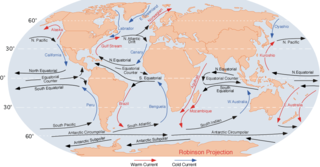
The Atlantic Ocean is the second-largest of the world's oceans, with an area of about 106,460,000 km2 (41,100,000 sq mi). It covers approximately 20 percent of Earth's surface and about 29 percent of its water surface area. It is known to separate the "Old World" from the "New World" in the European perception of the World.

The east coast of the United States, also known as the Eastern Seaboard, the Atlantic Coast, and the Atlantic Seaboard, is the coastline along which the eastern United States meets the North Atlantic Ocean. Regionally, the term refers to the coastal states and area east of the Appalachian Mountains that have shoreline on the Atlantic Ocean, from north to south, Maine, New Hampshire, Massachusetts, Rhode Island, Connecticut, New York, New Jersey, Delaware, Maryland, Virginia, North Carolina, South Carolina, Georgia and Florida.

Qetesh was a goddess who was incorporated into the ancient Egyptian religion in the late Bronze Age. Her name was likely developed by the Egyptians based on the Semitic root Q-D-Š meaning 'holy' or 'blessed,' attested as a title of El and possibly Athirat and a further independent deity in texts from Ugarit.

An ocean current is a continuous, directed movement of sea water generated by a number of forces acting upon the water, including wind, the Coriolis effect, breaking waves, cabbeling, and temperature and salinity differences. Depth contours, shoreline configurations, and interactions with other currents influence a current's direction and strength. Ocean currents are primarily horizontal water movements.

Astarte is the Hellenized form of the Ancient Near Eastern goddess Ashtart or Athtart, a deity closely related to Ishtar, worshipped from the Bronze Age through classical antiquity. The name is particularly associated with her worship in the ancient Levant among the Canaanites and Phoenicians, though she was originally associated with Amorite cities like Ugarit and Emar, as well as Mari and Ebla. She was also celebrated in Egypt and Hispania following the importation of foreign cults there.
672 Astarte is a minor planet orbiting the Sun.
The Pantheon Range is a subrange of the Pacific Ranges of the Coast Mountains in British Columbia. It is located between the edge of the Chilcotin Plateau at Tatla Lake on its northeast and the Klinaklini River on its west, with a southeastern boundary along Mosley Creek, a major tributary of the Homathko River. The range is 5550 km2 in area and extremely rugged, with many sharp, glaciated peaks.
The Prix Rothschild is a Group 1 flat horse race in France open to thoroughbred fillies and mares aged three years or older. It is run at Deauville over a distance of 1,600 metres, and it is scheduled to take place each year in late July or early August.

The Scorpion King 2: Rise of a Warrior is a 2008 American direct-to-DVD action adventure film prequel to the 2002 film The Scorpion King, itself a prequel to the 1999 reimagining of The Mummy. Filming for the film began on October 1, 2007, in Cape Town, South Africa. The film had a scheduled release date of August 19, 2008, in the United States, and was released on Blu-ray Disc and DVD.

Tokyo Red Hood is a Japanese manga written and illustrated by Benkyo Tamaoki. Its serialization began in the monthly Comic BIRZ in 2003. The manga is popular for its over-the-top gore and violence, and for the young main character and the different sex acts she partakes in.

Astartidae is a family of bivalves related in the order Carditida.
Astarte was an all-female black metal band from Athens, Greece, named after the goddess Astarte.
The Astarte fritillary is a butterfly of the family Nymphalidae. It is found from northwestern North America to northeastern Siberia. It is found as far south as Montana and Washington.

Astarte borealis, or the northern astarte, is a species of bivalve mollusc in the family Astartidae. It can be found along the Atlantic coast of North America, ranging from Greenland to Massachusetts.

Astarte elliptica, or the "elliptical astarte", is a species of bivalve mollusc in the family Astartidae. It can be found along the Atlantic coast of North America, ranging from Greenland to Massachusetts.

Astarte castanea, or the chestnut astarte, is a species of bivalve mollusc in the family Astartidae. It can be found along the Atlantic coast of North America, ranging from Nova Scotia to New Jersey.

Astarte undata, or the waved astarte, is a species of bivalve mollusc in the family Astartidae. It can be found along the Atlantic coast of North America, ranging from Labrador to Maryland.

Callicore astarte, the Astarte eighty-eight, is a species of butterfly of the family Nymphalidae. It is found from Mexico south to Brazil.

Astarte is a genus of bivalve mollusc in the Astartidae family. It was circumscribed by James Sowerby in 1816. As of 2017, WoRMS recognizes approximately 33 species in this genus.














